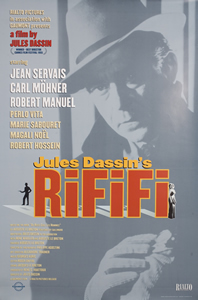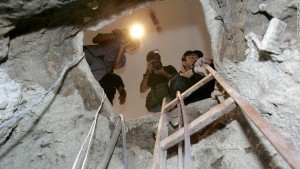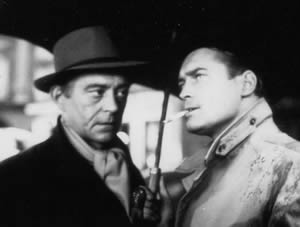‘Rififi’ – Film-noir Heist Flick All Filmmakers and Everyone Else Should Watch
(Originally published on Blogcritics.org)
The 1955 film Rififi should be seen and studied by every screenwriter and filmmaker. It is a near-perfect example of a heist flick, and a master class in how to structure a story Hollywood style. Ironically, the movie was created by filmmaker Jules Dassin, a man exiled from Hollywood. The film has been remastered and released in DCP format by Rialto Pictures and is playing this week in Los Angeles and New York.
 Rififi tells the story of Tony (Jean Servais), who, after serving a prison sentence, returns to the Paris criminal scene, and ends up part of the biggest jewel heist in history.
Rififi tells the story of Tony (Jean Servais), who, after serving a prison sentence, returns to the Paris criminal scene, and ends up part of the biggest jewel heist in history.
The Seminal Heist Flick
Rififi is a memorable film. When I was contacted by Rialto Pictures about its re-release, and then read the description, I was amazed, remembering it was a film my parents had taken me to see when I couldn’t have been more than 10 years old. It was like accidently running across an old childhood friend. I hadn’t remembered the name of the film, which is French slang for “rough and tumble” or “tough guy behavior.”
What stuck in my memory all those years was the jewel heist sequence mid-way through the film. It is the ultimate example of the direction given to new screenwriters, “Show, don’t tell.” There is no dialog or music for 35 minutes. Watching the film again, I noticed that this long, silent sequence was foreshadowed by another, shorter, sequence when Cesar, the safecracker played by director Dassin, shows up at the jewelry store to “case the joint.”
As an example for filmmakers, Rififi is notable for much more than its economical use of language. Every heist film made in the years following, including the Italian Job (both versions), Ocean’s 11 (and 13 and so on), and Entrapment demonstrate Rififi‘s influence. Even the sultry songstress (Janine Darcey) in the nightclub (a central location for much of the story), reminded me of Jessica Rabbit (Who Framed Roger Rabbit).
 Beyond the world of cinema, the week that the restored Rififi was rereleased, Scotland Yard revealed details of the April 7, 2015, Hatton Garden Heist. The London jewelry vault break-in has an amazing resemblance to the burglary inRififi. The accompanying photo from the London crime scene looks like it could have been a still from the movie.
Beyond the world of cinema, the week that the restored Rififi was rereleased, Scotland Yard revealed details of the April 7, 2015, Hatton Garden Heist. The London jewelry vault break-in has an amazing resemblance to the burglary inRififi. The accompanying photo from the London crime scene looks like it could have been a still from the movie.
The Hero’s Journey
The plot of Rififi follows the “hero’s journey,” a classic pattern for structuring a Hollywood film based upon the work of Joseph Campbell. This storytelling structure is explained for screenwriters in The Writers Journey: Mythic Structure for Writers by Christopher Vogler, and Story by Robert McKee.
Tony, the hero of Rififi, had taken the blame for a burglary in order to protect his young protégé, Jo the Swede, played by Carl Möhner. Five years later, Tony finds himself on the street, broke and sick, with Jo his only friend. Tony is the godfather for Jo’s five-year-old son, Tonio. He is a criminal, but he has shown love and the ability to sacrifice himself for a friend.
Tony is given a chance to get back in the game by participating in a quick smash-and-grab theft, but rejects the offer. Later, as events make him even unhappier with his current life, he reconsiders. He offers to participate, but only if the gang goes for the score of a lifetime, breaking into the vault of the biggest jewelry store in Paris.

Jean Servais, left, as Tony and Carl Möhner, right, as Jo in ‘Rififi’ (Credit: Rialto Pictures)
This motif: a protagonist, unhappy in the current world, first rejecting the offer of adventure, then choosing to go on the adventure that alters his life forever, is a narrative structure that goes back to the very beginnings of Western literature. It is reflected in thousands of fictional works: novels, plays, and movies. Rififi is a brilliant example of this story telling style.
Hollywood in Exile
So how could a film so Hollywood (and I mean that in a good way), come out of 1950s France? Filmmaker Jules Dassin was born in Connecticut and grew up in New York. He studied drama in Europe, acted in New York and wrote radio scripts. In 1940, he went to Hollywood where he was taken under the wing of Alfred Hitchcock.
In Rififi, first the stolen jewels, then the little boy Tonio, become what in movie parlance is known as a McGuffin, a term invented by Dassin’s mentor, Hitchcock.
Dassin directed a series of films for RKO, the only memorable one being The Canterville Ghost. In the late 40’s his reputation as a director of gritty dramas was established with Brute Force, The Naked City, andThieves’ Highway. His reputation was also established as a left-winger. He was denounced as a Communist to the House Un-American Activities Committee and was black-listed in Hollywood.
He moved first to England then to Greece, and after five years of struggle, was able to create Rififi, which launched his career in Europe.
Seeing the Film
Rififi, which in the sex-and-violence arena is tame by modern standards, caused an outrage in the 1950s. This required an edited version to be released in America. The restored Rialto Pictures version, now showing at the Film Forum in New York and the Laemmle in Los Angeles, is based on the original unedited version. The trailer is below.


